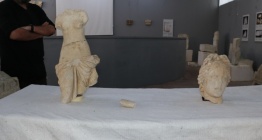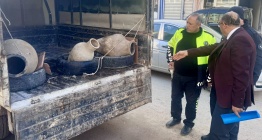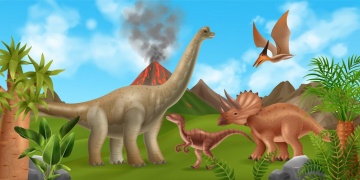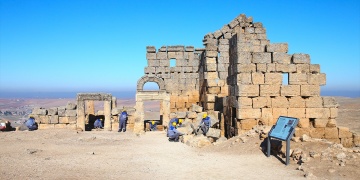Euphydryas iduna Butterfly went up to the slopes of Mount Agri 12,000 years ago during the Late Glacial Age and remained there after the glaciers began to form.
A globally near-threatened butterfly was photographed 50 years later at an altitude of 3,800 to 4,000 meters on eastern Mount Agri (Ağrı Dağı) by two experts.
Lapland Fritillary (Kuzeyli Nazuğum), Euphydryas iduna in Latin, was previously observed on Mount Agri on Aug. 4, 1970.
Nowadays, commonly found in the Scandinavian countries, only the high slopes of Mount Agri constitute the natural habitat of the butterfly in Turkey since the last Ice Age.
Nature conservationist, butterfly researcher Suleyman Eksioglu and wildlife specialist Emin Yogurtcuoglu told about their 3-day voyage of discovery.
''In the very first moment of discovery, we couldn’t believe it. Then, of course, we saw some more of this species,” Eksioglu said.
Eksioglu said: “Normally this is not the main distribution for Lapland Fritillary, but the last ice age forced them to migrate South as much as Turkey, then at the end of ice age some stayed in high mountains such as Mount Agri as a relict species.”
“Now there is nowhere for them to go. It’s stucked here between 3800 to 4000 meters of northern slopes of Mount Agri where mountain offers a climate similar to Scandinavian Lapland region,” he added.
Eksioglu said the butterfly went up to the slopes of Mount Agri 12,000 years ago during the Late Glacial Age and remained there after the glaciers began to form.
Stressing that Lapland Fritillary is accustomed to cold climates, he said: ''Future studies may provide information about the impact of global warming. We need to monitor butterflies regularly and see how much impact global warming has.”
Speaking to Anadolu Agency, Yogurtcuoglu said for his part that observing Lapland Fritillary creates “the feeling of encountering a prehistoric creature.”
“It was a great excitement for me to take part in rediscovering this species about which we have only a single documentation,” he added.
Yogurtcuoglu said it was also a “torture-like” experience to climb up to that height, adding: “It's hard to breathe and you have no idea where you're going, you're just there with a foresight – to rediscover the butterfly. So, the first time you see it, it is one of the most beautiful moments you can have in life.”
Yogurtcuoglu added “globally classified as near-threatened by IUCN (International Union for Conservation of Nature), this species probably is endangered or critically endangered in Turkey as a relict species which is stucked here at high alpine zones of Mount Agri. For them there is no way to go and global warming probably will affect them.”
“When I looked at the small size of the area where they lived on the mountain, this situation worried me the most.”
Anadolu Agency,








 Dinozor kıyametinde yanardağlar masum çıktı olağan şüpheli hâlâ dev göktaşı
Dinozor kıyametinde yanardağlar masum çıktı olağan şüpheli hâlâ dev göktaşı  Bir Sapiens kafilesi Avrupa'ya buz çağında ulaştı, soğuğa direndi ama soyunu sürdüremedi
Bir Sapiens kafilesi Avrupa'ya buz çağında ulaştı, soğuğa direndi ama soyunu sürdüremedi  Prof. Dr. Aytaç Coşkun: Zerzevan Kalesi'nin altında bir yeraltı kenti var
Prof. Dr. Aytaç Coşkun: Zerzevan Kalesi'nin altında bir yeraltı kenti var  Arkeologlar 4 Bin yıl önce salyangozların ne amaçla toplandığını çözmeye çalışıyor
Arkeologlar 4 Bin yıl önce salyangozların ne amaçla toplandığını çözmeye çalışıyor 




